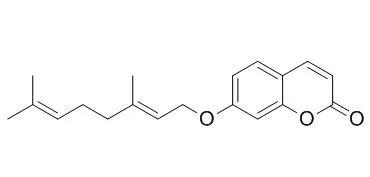| Cell Research: |
| J Alzheimers Dis. 2015;43(4):1215-28. | | Auraptene increases the production of amyloid-β via c-Jun N-terminal kinase-dependent activation of γ-secretase.[Pubmed: 25147119] | Amyloid-β (Aβ) peptide plays a major role in the pathogenesis of Alzheimer's disease (AD), and is generated by β- and γ-secretase-mediated proteolytic processing of amyloid-β protein precursor (AβPP).
METHODS AND RESULTS:
In the present study, we investigated the effect of 118 natural compounds on Aβ production in the medium of HEK293 cells stably expressing human AβPP695 (HEK293-AβPP) using Aβ42 sandwich ELISA to find natural compounds that can modulate Aβ production. We found that a coumarin derivative of citrus fruits, Auraptene, increased Aβ production. Treatment of HEK293-AβPP cells and rat primary cortical neurons with Auraptene significantly increased the secretion of Aβ40, Aβ42, and the Aβ42/40 ratio. However, Auraptene did not change the protein levels of the AβPP processing enzymes, a disintegrin and metalloproteinases 10 (ADAM10, α-secretase), β-site AβPP cleaving enzyme-1 (BACE-1, β-secretase), and presenilin 1 (PS1, γ-secretase component). Auraptene increased the activity of γ-secretase but not that of α- and β-secretase. Furthermore, Auraptene enhanced γ-secretase-mediated production of Aβ from AβPP or AβPP-C99, but not through α- and β-secretase. Auraptene also phosphorylated c-Jun N-terminal kinase (JNK), and pretreatment with the JNK inhibitor, SP600125, reduced Auraptene-induced γ-secretase activity.
CONCLUSIONS:
Overall, our results suggest that Auraptene-mediated activation of JNK may contribute to the production of Aβ by promoting γ-secretase activity. | | Mol Nutr Food Res. 2013 Jul;57(7):1135-44. | | Auraptene suppresses inflammatory responses in activated RAW264 macrophages by inhibiting p38 mitogen-activated protein kinase activation.[Pubmed: 23495198] | Inflammation plays a key role in obesity-related pathologies such as insulin resistance and type 2 diabetes. Hypertrophied adipocytes trigger the enhancement of macrophage infiltration and the release of various proinflammatory factors in obese adipose tissue. In this study, we examined whether Auraptene, a citrus-fruit-derived compound, could suppress the production of inflammatory factors that mediate the interaction between adipocytes and macrophages.
METHODS AND RESULTS:
Experiments using a co-culture system of 3T3-L1 adipocytes and RAW264 macrophages showed that Auraptene reduced the production of nitric oxide and tumor necrosis factor-α. In RAW264 macrophages, Auraptene also suppressed the inflammation induced by either LPS or the conditioned medium derived from 3T3-L1 adipocytes. In addition, Auraptene inhibited the phosphorylation of the p38 mitogen-activated protein kinase and suppressed the production of proinflammatory mediators in activated macrophages.
CONCLUSIONS:
Our findings indicate that Auraptene exhibits anti-inflammatory properties by suppressing the production of inflammatory factors that mediate the interaction between adipocytes and macrophages, suggesting that Auraptene is a valuable food-derived compound with a potential to attenuate chronic inflammation in adipose tissue and to improve obesity-related insulin resistance. |
|
| Animal Research: |
| Cancer Sci. 2007 Apr;98(4):471-7. | | Protective effects of citrus nobiletin and auraptene in transgenic rats developing adenocarcinoma of the prostate (TRAP) and human prostate carcinoma cells.[Pubmed: 17284254] | Dietary phytochemicals, including nobiletin and Auraptene, have been shown to exert inhibiting effects in several chemically induced carcinogenesis models.
METHODS AND RESULTS:
We here investigated the influence of nobiletin and Auraptene on prostate carcinogenesis using transgenic rats developing adenocarcinoma of the prostate (TRAP) bearing the SV40 T antigen transgene under control of the probasin promoter and human prostate cancer cells.
Starting at 5 weeks of age, male TRAP rats received powder diet containing 500 p.p.m. nobiletin or Auraptene, or the basal diet for 15 weeks and then were sacrificed for analysis of serum testosterone levels and histological changes. The body and relative prostate weights and serum testosterone levels did not differ among the groups. Since all animals developed prostate carcinomas, these were semiquantitatively measured and expressed as relative areas of prostate epithelial cells. Nobiletin caused significant reduction in the ventral (P<0.01), lateral (P<0.001) and dorsal (P<0.05) prostate lobes, while decreasing high grade lesions (P<0.05) in the ventral and lateral lobes. Feeding of Auraptene also effectively reduced the epithelial component (P<0.05) and high grade lesions (P<0.05), in the lateral prostate. A further experiment demonstrated that growth of androgen sensitive LNCaP and androgen insensitive DU145 and PC3 human prostate cancer cells, was suppressed by both nobiletin and to a lesser extent Auraptene in a dose-dependent manner, with significant increase in apoptosis.
CONCLUSIONS:
In conclusion, these compounds, particularly nobiletin, may be valuable for prostate cancer prevention. |
|






 Cell. 2018 Jan 11;172(1-2):249-261.e12. doi: 10.1016/j.cell.2017.12.019.IF=36.216(2019)
Cell. 2018 Jan 11;172(1-2):249-261.e12. doi: 10.1016/j.cell.2017.12.019.IF=36.216(2019) Cell Metab. 2020 Mar 3;31(3):534-548.e5. doi: 10.1016/j.cmet.2020.01.002.IF=22.415(2019)
Cell Metab. 2020 Mar 3;31(3):534-548.e5. doi: 10.1016/j.cmet.2020.01.002.IF=22.415(2019) Mol Cell. 2017 Nov 16;68(4):673-685.e6. doi: 10.1016/j.molcel.2017.10.022.IF=14.548(2019)
Mol Cell. 2017 Nov 16;68(4):673-685.e6. doi: 10.1016/j.molcel.2017.10.022.IF=14.548(2019)